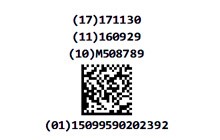To meet customer and regulatory requirements, we began adding two-dimensional (2D) GS1 Data Matrix bar codes to product packages in 2015. The GS1 bar codes comply with unique device identifier (UDI) requirements mandated by the FDA to adequately identify medical devices throughout their distribution and use.
To include all the necessary information on the bar code label without increasing packaging, some of the linear bar codes have been replaced by 2D GS1 codes. See a list of the impacted products ›
Note: Reading 2D bar codes may require upgrading your facility's scanning equipment in the receiving area. Please communicate this change to all appropriate individuals.
Examples:

Example of a 2D GS1 Data Matrix bar code

Example of a linear HIBC bar code
No action is required in the laboratory. The bar code changes will not affect the reagent bar codes read by Beckman Coulter instruments.
If you have any questions, please contact customer support at 1-800-854-3633 from the U.S. or Canada. Outside of North America, call +353 65 683 1170 or contact your local Beckman Coulter representative.
Frequently asked questions
- What is the timeline for the change to the impacted products? When will customers need to have the capability to read the new bar codes?
We began adding 2D GS1 Data Matrix bar codes to product packages in 2015. After September 24, 2016, some products will have only 2D GS1 Data Matrix bar codes. See a list of products that will have only 2D GS1 Data Matrix bar codes. Customers needing to read the bar codes of these products must have the capability to do so on or before September 24, 2016.
- What drove the adoption of the new bar code standard?
The added GS1 bar codes comply with unique device identifier (UDI) requirements mandated by the FDA to adequately identify medical devices throughout their distribution and use.
- What type of reader will be required to read the new bar code?
Any 2D-headed scanner will work. The type of device required will depend on the specific systems of the facility and should be defined by their receiving department.
- Does Beckman Coulter have any recommendations for bar code-reading systems?
No. We do not make recommendations on bar code-reading systems.
- Does Beckman Coulter provide bar code-reading systems or subsidize customers in purchasing them?
No. We do not provide bar code-reading systems or subsidize customers in purchasing them.
- Will this bar code change affect the reagent bar codes used when operating Beckman Coulter instruments?
The reagent pack, bottle and cartridge bar code labels are not changing. The change only affects the product packaging or box.
- Are there any plans to change the reagent bar codes in the near future?
No, there are not any plans to change the reagent bar codes in the near future.
- If a facility does not use a bar code-reading system, is there any action the laboratory needs to take?
If the facility currently does not use a bar code-reading system, then no action is required.
- What information is in the 2D GS1 DataMatrix bar code that isn’t in the linear one?
The date of manufacture and Global Trade Item Number (GTIN) are in the new bar code. The product item number is not in the GS1 bar code.
- Will there be any delay in the laboratory receiving products if it does not upgrade to the current bar code-reading system?
To avoid any delay in receiving products, the laboratory should consult with the facility’s receiving department to ensure necessary upgrades are in place.
- If the laboratory upgrades its bar code-scanning system, can it still read the linear bar codes?
The laboratory needs to have a system that is able to read both types of bar codes.
 English
English



